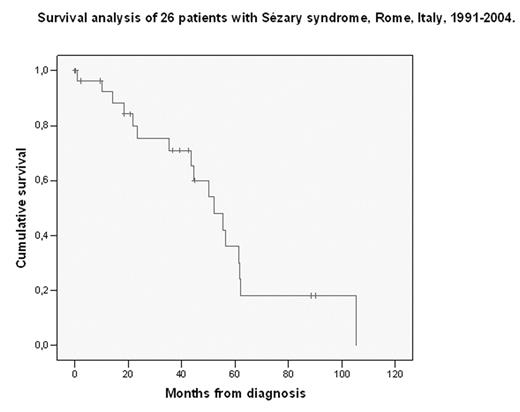Abstract
We created a relational database of patients with cutaneous T-cell lymphoma (CTCL) to collect in a standardised fashion, anagraphic variables, clinical history, clinical, histological, haematological, and immunological information on CTCL patients hospitalised at IDI-IRCCS, Rome, Italy. At present, there are data on 424 patients, hospitalised from 1983 to July 2005. Active follow-up is performed yearly to ensure a standardised ascertainment of survival time. For deceased patients, the actual date of death (for all causes) is recorded, while surviving patients are censored at the date of last contact.
The database includes 29 patients with Sezary syndrome (SS). Follow-up times ranged from 0 to 105 months. At first hospitalisation the median values of cells/mL were: white blood cells (WBC) 8750, neutrophils 4250, eosinophils 140, basophils 120, lymphocytes 2760, monocytes 500, CD3+ 2780, CD4+ 2431, CD8+ 192, CD19+ 96. Seventeen patients were deceased. We included in the Kaplan-Meier survival analysis only patients who were diagnosed before July 2004 (n=26). Median survival time from diagnosis was 52 months. No significant differences were observed in mortality for WBC (cutoff 9000 cells/uL), neutrophils (cutoff 4500 cells/uL), basophils (cutoff 200 cells/uL), lymphocytes (cutoff 3000 cells/uL), monocytes (cutoff 500 cells/uL), CD3+ (cutoff 2000 cells/uL), CD4+ (cutoff 2000 cells/uL), CD8+ (cutoff 200 cells/uL), CD19+ (cutoff 70 cells/uL). A lower survival was observed for patients with eosinophils <200 cells/uL (p=.08).
Survival in patients with SS does not seem to be influenced by haemathologic parameters. However, patients with long-term survival (>90 months) are observed, and their characteristics should be further investigated.
Survival analysis of 26 patients with Sézary syndrome, Rome, Italy, 1991–2004.
Survival analysis of 26 patients with Sézary syndrome, Rome, Italy, 1991–2004.
Author notes
Corresponding author


This feature is available to Subscribers Only
Sign In or Create an Account Close Modal